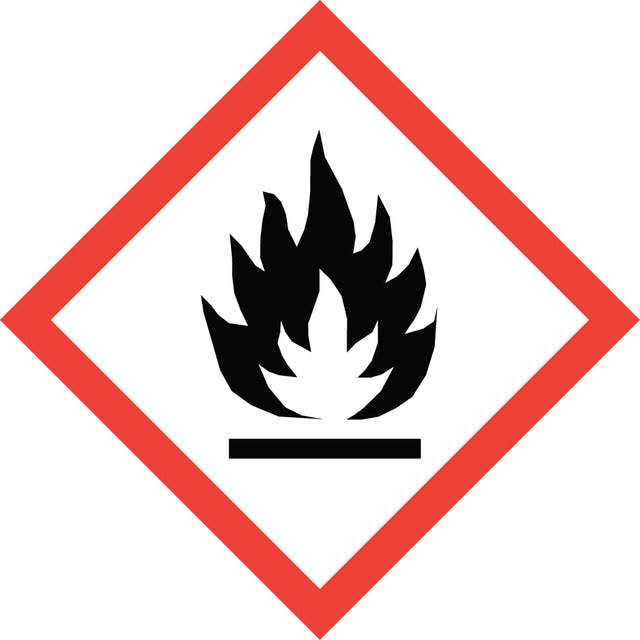Sign In to View Organizational & Contract Pricing
Select a Size
About This Item
Linear Formula:
(CH3)2C=CHCH=C(CH3)2
CAS Number:
Molecular Weight:
110.20
Beilstein:
1733342
EC Number:
MDL number:
UNSPSC Code:
12352100
PubChem Substance ID:
NACRES:
NA.22
vapor density
3.8 (vs air)
vapor pressure
26.9 mmHg ( 37.7 °C)
7.2 mmHg ( 20 °C)
Assay
96%
form
liquid
autoignition temp.
559 °F
refractive index
n20/D 1.476 (lit.)
bp
132-134 °C (lit.)
mp
11-14 °C (lit.)
density
0.773 g/mL at 25 °C (lit.)
SMILES string
C\C(C)=C/C=C(\C)C
InChI
1S/C8H14/c1-7(2)5-6-8(3)4/h5-6H,1-4H3
InChI key
DZPCYXCBXGQBRN-UHFFFAOYSA-N
Looking for similar products? Visit Product Comparison Guide
General description
2,5-Dimethyl-2,4-hexadiene is an electron-rich alkene. It induces photodechlorination of 9,10-dichloroanthracene and its mechanism has been investigated. Asymmetric cyclopropanation of 2,5-dimethyl-2,4-hexadiene with tert-butyl diazoacetate catalyzed by the new copper-bisoxazoline complex has been reported. 2,5-Dimethyl-2,4-hexadiene has been investigated as a singlet oxygen acceptor in various solvents. Mechanism of addition reaction of aromatic and aliphatic thiols with 2,5-dimethyl-2,4-hexadiene has been investigated.
Application
2,5-Dimethyl-2,4-hexadiene may be used in the synthesis of (+)-trans-(1R,3R)-chrysanthemic acid methyl ester.
Signal Word
Warning
Hazard Statements
Precautionary Statements
Hazard Classifications
Eye Irrit. 2 - Flam. Liq. 3 - Skin Irrit. 2 - STOT SE 3
Target Organs
Respiratory system
Storage Class Code
3 - Flammable liquids
WGK
WGK 3
Flash Point(F)
84.2 °F - closed cup
Flash Point(C)
29 °C - closed cup
Personal Protective Equipment
dust mask type N95 (US), Eyeshields, Gloves
Regulatory Information
危险化学品
This item has
Choose from one of the most recent versions:
Already Own This Product?
Find documentation for the products that you have recently purchased in the Document Library.
Interactions of singlet oxygen with 2, 5-dimethyl-2, 4-hexadiene in polar ano non-polar solvents evidence for a vinylog ene-reaction.
Gollnick K and Griesbeck A.
Tetrahedron, 40(17), 3235-3250 (1984)
Organic sulfur compounds. VII. Some addition and co-oxidation reactions of thiols with 2, 5-dimethyl-2, 4-hexadiene.
Oswald AA, et al.
The Journal of Organic Chemistry, 27(7), 2439-2448 (1962)
Makoto Itagaki et al.
The Journal of organic chemistry, 70(8), 3292-3295 (2005-04-13)
Some new bisoxazoline ligands with an aryl group at the 4-position and gem-dimethyl groups at the 5-position on the oxazoline ring were prepared from arylglycines. Remarkable enhancement of the trans-selectivity (trans/cis = 87/13) and the enantioselectivity (96% ee for the
Maki Ohashi et al.
Organic letters, 10(13), 2741-2743 (2008-06-10)
The synthesis of monoalkylated propanedinitriles was achieved upon photoirradiation of MeCN/H(2)O solutions containing propanedinitrile (1; malononitrile) and electron-rich alkenes in the presence of lithium carbonate and a catalytic amount of 9-cyanophenanthrene or redox-type photosensitizers (electron-mediating photosensitizers), through regioselective anti-Markovnikov photochemical
J Saltiel et al.
Photochemical & photobiological sciences : Official journal of the European Photochemistry Association and the European Society for Photobiology, 8(6), 856-867 (2009-06-06)
Photochemical formation of 9-chloroanthracene (MCA) from 9,10-dichloroanthracene (DCA) is observed in the presence of 2,5-dimethyl-2,4-hexadiene (DMH) in acetonitrile (AN). The mechanism of the reaction was investigated using kinetics, deuterium labeling, and quenching techniques. Contrary to conclusions in a recent publication
Our team of scientists has experience in all areas of research including Life Science, Material Science, Chemical Synthesis, Chromatography, Analytical and many others.
Contact Technical Service
